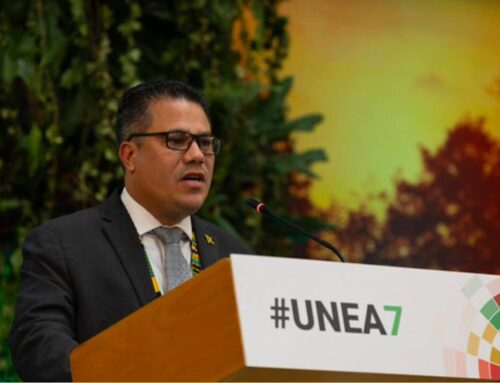Johnson County seeks disaster relief. Will it see state, federal help for forever chemical
April 1, 2025
After requesting emergency assistance from state officials, Johnson County leaders say they have yet to see funding to help farmers, who believe their land, water and cattle have been contaminated by harmful chemicals.
Johnson County Judge Christopher Boedeker says the county has had “significant” communication with the Texas Division of Emergency Management, which responds to the governor’s office. The department is working with federal officials to determine if Johnson County will be eligible for federal emergency funds, said Boedeker.
County commissioners declared a state of disaster Feb. 11 after “dangerous” levels of PFAS — also known as forever chemicals because they accumulate in the environment rather than break down — were found in soil, groundwater, surface water and animal tissue throughout a farm in Johnson County, according to a news release. Residents have filed suit against Synagro, which formerly produced biosolids fertilizer from Fort Worth’s sewage sludge and applied it to nearby farmland. The city ended its contract with the company in March.
The county has not yet received a definitive response from the governor’s office regarding whether or not Gov. Greg Abbott will declare an emergency, Boedeker told the Report. The governor is the only entity who can declare a disaster in order to request federal aid.
How do PFAS affect human health?
According to the Environmental Protection Agency, scientific studies show that exposure to certain levels of PFAS can lead to adverse health risks such as:
- Decreased fertility or increased high blood pressure in pregnant women
- Developmental effects or delays in children
- Increased risk of some cancers
- Reduced immunity and reduced vaccine response
- Interference with the body’s natural hormones
- Increased cholesterol and risk of obesity
Boedeker and Johnson County Commissioner Larry Woolley also have looked to Texas Agriculture Commissioner Sid Miller to manifest state or federal assistance.
In an interview with the Report, Miller said he has met with U.S. Secretary of Agriculture Brooke Rollins — a North Texas native and Fort Worth resident — to help reimburse the farmers affected by PFAS.
“That hasn’t taken place yet, but it’s in the works,” said Miller.
He is also working with State Rep. Helen Kerwin, R-Cleburne, to develop new laws aimed at regulating PFAS. House Bill 1674, filed by Kerwin, would prohibit the manufacturing and distribution of certain levels of forever chemicals.
Boedeker also backs the bill, hoping it is passed before the effects of PFAS in biosolids could “become a significant problem across the state.”
“We’re really trying to collaborate with every arm of the state to make sure that we’re doing what we need to do on our end to address the issues,” said Boedeker.
Through the Emergency Commodity Assistance Program, passed by Congress in December, the U.S. Department of Agriculture is set to issue up to $30 billion in economic and disaster aid. The first $10 billion rolling out of the program is designed to help farmers navigate the impacts of falling commodity prices.
Through this program, affected farmers in Johnson County should qualify to receive the funds, said Miller.
“I think, by all means, (Johnson County) just meets the definition of a disaster,” said Miller.
Tony Coleman, a Johnson County resident, sells the cattle he raises on his farmland. He reported 50 deaths out of a herd of 150, shortly after the biosolids fertilizer was applied to a neighbor’s farmland in late 2022. He told the Report in January he could not sell the cattle “in good conscience” knowing that could potentially lead to human health effects.
Assistance from the Texas Department of Agriculture or the USDA would go toward additional testing of animals believed to be affected by PFAS, such as Coleman’s, and the euthanasia of the animals to protect the residents’ food supply, according to Boedeker.
“It’s not only an environmental issue. It’s really an agricultural issue as well,” said Boedeker. “It’s an economic development issue. It’s an ability to live and work and spend your life in Johnson County and other counties in the state.”
Woolley is optimistic the county will receive funding to address PFAS in the area. He pointed to the city of Fort Worth’s recent lawsuit against the federal government and companies as a tool to “solidify and validate” Johnson County’s concerns to the federal government. In the suit, city leaders allege the U.S. Department of Defense and major companies used products with PFAS, ultimately contaminating the city’s water supply.
“That’s another pivotal occurrence here in this whole scenario,” said Woolley.
Fort Worth leaders dismissed the case to join a multi-district lawsuit out of South Carolina. The case also seeks to hold the federal government and chemical companies liable for PFAS contamination.
Synagro says its fertilizer is not the source of contamination
When Johnson County called on Public Employees for Environmental Responsibility, or PEER, to test Synagro’s biosolids as part of a criminal investigation last year, the advocacy group of scientists detected 13,000 parts per trillion of the chemicals in the fertilizer.
The Environmental Protection Agency’s limits on some types of forever chemicals in drinking water is set at 4 parts per trillion, the lowest level that can be “effectively” implemented while reducing exposure, according to the EPA.
Although the EPA has not outlined limits of PFAS in the fertilizer, the agency issued a risk assessment in January concluding that “there may be human health risks associated with exposure to the ‘forever chemicals’” in biosolids. That was before the Trump administration took over the EPA with a vow to rescind 31 environmental rules, including regulation on industrial pollution restriction, protecting wetlands and soot pollution limits.
In a study released March 18, Synagro stated its biosolids fertilizer was not the source of PFAS levels found in samples of a pond where fish and animals allegedly died after fertilizer was applied.
Synagro decided to conduct its own study after being met with a 2024 lawsuit from five Johnson County farmers, alleging the biosolids fertilizer led to contamination.
“We wanted to get at the truth and the facts and say, “you know, is this possible?’” said Synagro chief commercial officer Pam Racey.
While PEER’s study showed the biosolids had high levels of forever chemicals, individual PFAS chemicals in water samples — pond and well water — from Johnson County did not exceed the EPA’s limits for drinking water, with the exception of PFPrA. The PFAS chemical is made of small compounds that are hardest to remove in water treatment.
Kyla Bennett, PEER’s director of science policy, said the difference between Synagro’s and PEER’s findings could be due to several factors, including the fluid composition of chemicals in the fertilizer, how PFAS migrate through soil and water and when samples from water, soil and animal tissue were taken.
“The composition of biosolids is not stable,” said Bennett. “It changes daily, depending on what’s coming into the wastewater treatment plant. So every time we look at biosolids, we’re taking a snapshot in time.”
Synagro collected samples in May and June 2024 from a farm in Grandview that used biosolids, according to the study. PEER collected samples in 2022 and 2023 from adjacent properties in the county, according to Bennett.
Even if biosolids were not applied to farmland, forever chemicals would still be detected in those samples, said Racey.
“There’s PFAS everywhere, it’s ubiquitous in the environment,” said Racey.
But Bennett said there is no such thing as “background concentrations” of PFAS cited by Synagro in its study.
“PFAS are manmade chemicals, and they are not naturally found in the environment,” said Bennett. “Whenever you find PFAS in the environment, it’s because of contamination.”
Aside from when samples were collected, Synagro used a testing method that does not detect as many PFAS chemicals as PEER reported, said Bennett.
“They do fluctuate,” said Bennett. “It’s disingenuous for them to say there’s no way that these PFAS found on the farms can be from the biosolids because of this.”
PFPrA was the only chemical with elevated concentrations in Synagro’s water and soil samples but was not found in the fertilizer, according to the company’s study.
As for the high levels of PFAS in water, soil and animal samples reported by PEER, the answer is not simple. After reviewing PEER’s report, the death of cattle points to parasites and selenium toxicity as the cause, according to Racey. Insecticides and fracking lines could have potentially led to higher concentrations of PFAS in the county’s soil and groundwater, she added.
But Bennett argues Johnson County farmers in the lawsuit do not apply insecticides. She said she looks forward to Synagro releasing its full report so she and others involved with the case can further assess its testing methods and data.
Synagro’s full report will be released at a later date due to ongoing litigation against the company, Racey said.
“We were anxious to get the conclusions out there, because obviously, a lot of things have been said that we want to get our side of the story out,” said Racey.
Nicole Lopez is the environment reporter for the Fort Worth Report. Contact her at nicole.lopez@fortworthreport.org.
At the Fort Worth Report, news decisions are made independently of our board members and financial supporters. Read more about our editorial independence policy here.
This article first appeared on Fort Worth Report and is republished here under a Creative Commons Attribution-NoDerivatives 4.0 International License.
Search
RECENT PRESS RELEASES
Related Post



